
Have you ever heard Het Wilhelmus, the Dutch national anthem? It’s one of the oldest anthems in existence, and therefore the lyrics are not always easy to understand, full of old-fashioned words and unusual turns of phrases. It’s an anthem of fifteen verses, but mainly the first (and sometimes also the sixth) verse is sung. However, because of the old nature of the Dutch anthem, not all Dutch know the words or understand the meaning. Why is the Spanish king mentioned in the Dutch national anthem? And what about that mention of German blood?
As you can see, the Dutch anthem is not free of controversy, and some people even say that it should be changed. However, although the Dutch don’t sing their national anthem very often, when they sing it on special occasions, everybody will sing along, even those that don’t know all the words, as you can always mumble or hum along.
In this article, we will first show you the history of the Dutch national anthem. We’ll then talk about its lyrics, the meaning of the Dutch anthem, and the criticisms it has received.
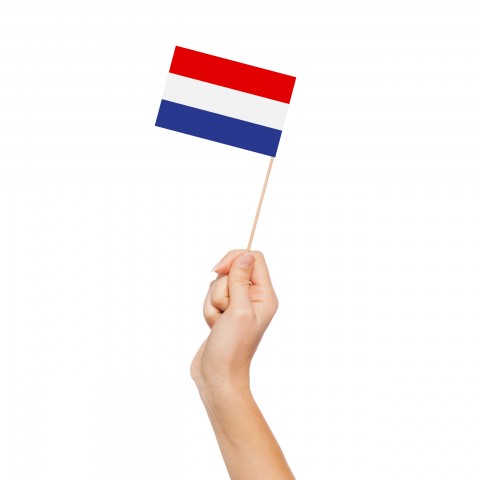
 Table of Contents
Table of Contents
- The History
- Explaining the Lyrics of Het Wilhelmus
- When is it Played?
- Should the Netherlands Find a New National Anthem?
- How DutchPod101 Can Help You Learn More Dutch
1. The History
Before we have a look at the lyrics of the Dutch national anthem, it might come in handy to first learn more about its history. This way you will be able to understand better what it’s all about.
So, the Dutch national anthem is actually one of the world’s oldest patriotic songs, as it dates back to at least 1572. The lyrics were written at the beginning of the Eighty Years’ War (1568-1648), also known as The Dutch War of Independence. The Dutch anthem, therefore, tells the story of Willem van Oranje (“William of Orange”) and his fight against the King of Spain in order to gain independence for the Netherlands. The anthem is written from William’s perspective and follows his struggle to remain loyal to the Spanish king, who he has always served, while also serving God and leading his people in the fight against persecution.
But who is Willem van Oranje? He is also known as Willem van Nassau, or in old Dutch Wilhelmus van Nassouwe, which explains the title of the Dutch anthem. He was one of the main leaders of the Dutch revolt against the Spanish that set off the Eighty Years’ War and resulted in the formal independence of what now is known as (part of) the Netherlands. He is, therefore, also known as Vader des Vaderlands (“Father of the Fatherlands”). Besides this, he is also the founder of the Orange-Nassau royal family, which makes him the ancestor of the Dutch monarchy.
It took some time before Het Wilhelmus officially became the Dutch national anthem. At the beginning of the 19th century, the song was mainly sung by supporters of the Dutch royal family. However, they were not particularly popular during this period. So, when Het Wilhelmus became the official Dutch national anthem in 1932, there were protests.
But what changed in the following years? During the Nazi occupation of the Second World War, the Dutch national anthem regained popularity. This song of victory served as a way to express Dutch national pride and solidarity.
2. Explaining the Lyrics of Het Wilhelmus
So, as you now know the history of the Netherlands’ national anthem, it’s time to have a look at the lyrics of Het Wilhelmus.
1- The Lyrics
- ➜ Do you have difficulties understanding Dutch? Let’s have a look at these useful tips on How to Improve Your Listening Skills.
The Dutch anthem has an impressive fifteen verses; the first letter of all verses originally formed the word Willem van Nassov, another old Dutch way to say Willem van Nassau. However, the Dutch only sing one or two verses of the anthem. It’s mainly the first verse that is sung, sometimes followed by the sixth verse.
Also you may notice, even in the contemporary Dutch version, some of the words have been changed so that they fit the rhythm or so they rhyme. So, don’t worry if you can’t always figure out some of the words.
Verse 1
| Old Dutch | Contemporary Dutch | Translation |
| Wilhelmus van Nassouwe Ben ick van Duytschen Bloedt, Den Vaderland ghetrouwe Blijf ick tot inden doet; Een Prince van Orangien Ben ick vry onverveert. Den Coninck van Hispangien. Heb ick altijt gheeert. | Wilhelmus van Nassouwe Ben ik van Duitsen bloed Den vaderland getrouwe Blijf ik tot in den dood. Een Prinse van Oranje Ben ik, vrij onverveerd. Den Koning van Hispanje Heb ik altijd geëerd. | “William of Nassau, Am I of German descent True to the fatherland I remain until death. Prince of Orange Am I, free and fearless To the King of Spain I have always given honor.” |
Verse 6
| Old Dutch | Contemporary Dutch | Translation |
| Mijn schilt ende betrouwen Zijt ghy, O Godt, mijn Heer. Op U soo wil ick bouwen, Verlaet my nimmermeer; Dat ick doch vroom mag blijven U dienaer t’aller stondDie tyranny verdrijven, Die my mijn hert doorwondt. | Mijn schild ende betrouwen Zijt Gij, o God mijn Heer. Op U zo wil ik bouwen, Verlaat mij nimmermeer; Dat ik doch vroom mag blijven, Uw dienaar t’aller stond. De tirannie verdrijven, Die mij mijn hart doorwondt. | “You, my God and Lord, Are my shield, on You I rely. On You I will build, Never leave me; So that I may remain pious, Your servant at all moments. Dispelling the tyranny. That wounds my heart.” |
2- Why Does the Dutch Anthem Mention Duitsen bloed?
It may have surprised you to read that the Dutch national anthem mentions Duitsen bloed in the first verse. This means “German blood” or “German descent”. And many Dutch also interpret it this way. However, Germany did not exist yet during Willem van Oranje’s life. Some say that it therefore does not refer to Germany but the lowlands area that includes what we now know as the Netherlands and certain areas of Germany, where William of Orange was also born.
3. When is it Played?
The Dutch in general aren’t the most nationalistic people out there. However, there are some occasions when they let their national pride flow. And this is often also the moment where Het Wilhelmus is played.
It’s probably most likely that you hear the Dutch national anthem during international sporting events, such as the European or World Cup football tournaments. Another popular event is the Olympic Games, where the Dutch anthem is played when a Dutch sportsman- or woman wins an Olympic gold medal. So especially during the Winter Olympics you might be able to enjoy the Dutch national anthem a few times.
- ➜ Do you want to celebrate the Olympic Games with the Dutch? Be sure to check out our useful vocabulary lists on the Summer and Winter Olympics.
Furthermore, there are some rare national moments when the Dutch also sing their anthem. And they all happen to take place around the same period: Koningsdag (“King’s day”) on the 27th of april, Dodenherdenking (“National Remembrance Day”), on the 4th of May, and Bevrijdingsdag (“Liberation Day”) on the 5th of May.
- ➜ Would you like to know how to talk in Dutch about these special national days? Have a look at our Liberation Day, National Remembrance Day and King’s Day vocabulary lists with useful audio recordings to practice your pronunciation.
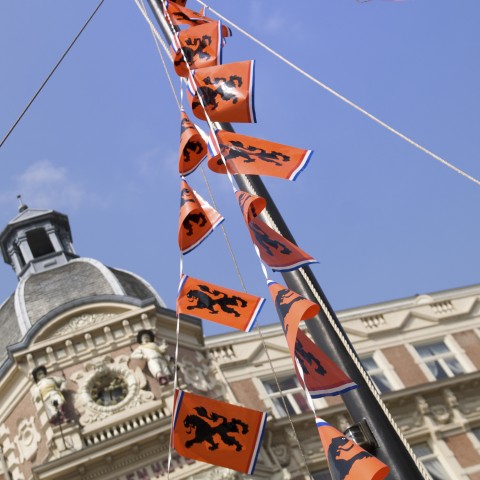
Finally, another moment when the Dutch anthem is played is when the Netherlands hosts a foreign head of state.
4. Should the Netherlands Find a New National Anthem?
As you might already have guessed, the Dutch national anthem is not free of controversy. German blood, the King of Spain and dispelling tyranny: Het Wilhelmus is more of a historical text than a contemporary national anthem.
Some attempts to modernize the Dutch anthem have been made, for example by a former lady-in-waiting of Queen Beatrix:
Wilhelmus van Nassouwe,
De Vader van ons land
Symbool van het vertrouwen,
in onze vaste band.
Met allen die hier leven,
In vrijheid en in recht
Moog dat ons voor altijd zijn gegeven,
zoals ons is toegezegd.
(“William of Nassouwe,
The Father of our country
Symbol of confidence,
in our firm bond.
With all who live here,
In freedom and in justice
May we be given that forever,
as promised to us.”)
However, this nor any other attempts have been successful. Many still see the Dutch anthem as cultural heritage.
Other arguments against the Netherland’s national anthem are related to the difficult melody and lyrics. The rhythm of the song is very slow, making it difficult to sing along. The complex lyrics also do not help: 43% of the Dutch do not know Het Wilhelmus by heart, not even the first verse.
And this also brings us to the core of the problem: many Dutch don’t really know their anthem’s meaning or the historical references it makes. While it would also get more interesting when you really know what you are singing about.
5. How DutchPod101 Can Help You Learn More Dutch
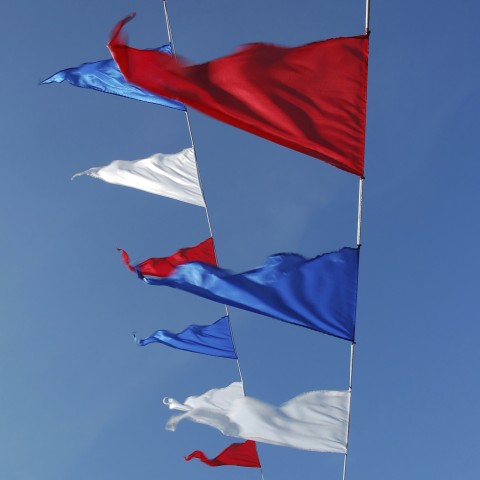
In this guide, you have learned everything about Het Wilhelmus, the Dutch anthem: from its history, lyrics, occasions to some interesting controversies. You now might even know more about the Dutch anthem than many Dutchies do. What do you think about the Dutch national anthem? Do you know any other interesting things about its history that we forgot to mention? Share them with us in the comments!
DutchPod101 hosts a range of vocabulary lists with audio recordings and other free resources to boost your studies.
Would you like some special attention? Remember that we also offer a Premium PLUS service with personal 1-on-1 coaching: MyTeacher. Let your private teacher help you master the Dutch language. You’ll receive personalized exercises, constructive feedback, and interactive assignments.

Useful Dutch Classroom Phrases and Vocabulary

Would you like to study or teach in the Netherlands? Then it might be handy to know the most common Dutch classroom phrases for students and teachers. Whether you’re about to join a study program as a foreign student in the Netherlands, start one of those Dutch language courses, or teach in a Dutch school, you will have to learn how to communicate in the classroom.
As a student, it will be handy to know how to address your teachers in Dutch, ask questions, and understand instructions. And as a teacher, you might want to know how to ask questions, give instructions, and, yes, how to discipline your students.
From Dutch classroom greetings to Dutch classroom command phrases, you will have to know or understand them. In this guide, you’ll find everything you need to know as a teacher or a student, from common classroom phrases to useful classroom vocabulary in Dutch.
Happy learning (or teaching)!

 Table of Contents
Table of Contents
- School Vocabulary
- Teacher’s Phrases
- Student’s Phrases
- Tests Instructions
- How DutchPod101 Can Help You Learn More Dutch
1. School Vocabulary
Before we start with the phrases, let’s first see some classroom vocabulary in Dutch. From educational buildings to subjects to supplies, it will help you find your way around the schoolyard or the campus.
1- Educational Infrastructures
| Gebouw | Building |
| Schoolplein | Schoolyard |
| Gang | Hallway |
| Klaslokaal | Classroom |
| Kantine | Canteen |
| Secretariaat | Secretariat |
| Lerarenkamer | Teachers’ roo |
| Bibliotheek | Library |
| Gymzaal | Gym |
| Collegezaal | Lecture hall |
2- Subjects

| Wiskunde | Math |
| Biologie | Biology |
| Scheikunde | Chemistry |
| Informatica | Computing |
| Natuurkunde | Physics |
| Kunst | Art |
| Tekenen | Drawing |
| Nederlands | Dutch |
| Frans | French |
| Engels | English |
| Duits | German |
| Spaans | Spanish |
| Filosofie | Philosophy |
| Latijns | Latin |
| Grieks | Greek |
| Economie | Economy |
| Maatschappijleer | Social studies |
| Geschiedenis | History |
| Aardrijkskunde | Geography |
| Muziek | Music |
| Lichamelijke opvoeding | Physical education (PE) |
- ➜ To practice your pronunciation, have a look at our free Dutch vocabulary list on School Subjects, with recorded words and example phrases, on DutchPod101.
2- School Supplies
| Schrift | Notebook |
| Map | Binder |
| Vel papier | Sheet of paper |
| Boek | Book |
| Pen | Pen |
| Potlood | Pencil |
| Gum | Eraser |
| Puntenslijper | Pencil sharpener |
| Etui | Pen case |
| Rugzak | Backpack |
| Rekenmachine | Calculator |
| Schaar | Scissors |
| Liniaal | Ruler |
- ➜ For more Back to School Essentials, School and Classroom vocabulary, be sure to explore our free vocabulary lists with audio recordings.
2. Teacher’s Phrases

As a teacher, you need to be able to give instructions, ask questions and, every now and then, bring some discipline to the classroom. And as a student, it’s also very useful to learn these phrases, as it’s important that you understand your teacher.
Let’s see some of the most common Dutch classroom command phrases.
1- Instructions
| Vandaag gaan we vervoegingen leren. (“Today we are going to learn conjugations.”) |
| Open je boek op pagina 12. (“Open your book on page 12.”) |
| Pak een vel papier. (“Take a sheet of paper.”) |
| Steek je hand op als je het antwoord weet. (“Raise your hand if you have the answer.”) |
| Luister en herhaal na mij. (“Listen and repeat after me.”) |
| Kijk naar de afbeelding op het scherm. / Kijk naar de afbeelding op het bord. (“Look at the picture on the screen.” / “Look at the picture on the board.”) |
| Schrijf deze zin op. (“Write this sentence.”) |
| Spel dit woord. (“Spell this word.”) |
| Maak een zin met het woord “vakantie”. (“Make a sentence with the word “holiday””.) |
| Hoe zeg je “tomorrow” in het Nederlands? (“How do you say “tomorrow” in Dutch?”) |
| We gaan kleine groepjes vormen. (“We will form small groups.”) |
2- Questions
| Begrijp je deze zin? (“Do you understand this sentence?”) |
| Wat betekent dat? (“What does that mean?”) |
| Wie kan deze vraag beantwoorden? (“Who can answer this question?”) |
| Wat is het juiste antwoord? (“What is the correct answer?”) |
| Wie wil er hardop voorlezen? (“Who wants to read aloud?” |
3- Discipline
| Ga zitten. (“Take a seat.”) |
| Stilte alstublieft. (“Silence, please.”) |
| Let op. (“Pay attention.”) |
| Stop met praten. (“Stop talking.”) |
- ➜ Are you going to live on a Dutch campus? Find your way there with our free vocabulary list with Dutch Words and Phrases for Living on a School Campus, complete with examples and recordings.
3. Student’s Phrases
So, let’s now see some useful Dutch classroom phrases that students use: from addressing teachers, to asking questions, to stating your problem.
1- Addressing Teachers
In primary school, school teachers are addressed as :
- [Male] Meester (Literally: “Master”)
- [Female] Juf or juffrouw (Literally: “Miss”)
In High school and University, teachers are addressed as meneer (“Mister”) and mevrouw (“Madam” or “Mrs”), often combined with their last name.
So in Dutch classroom greetings, as a student, you could just say Hallo meneer van der Zand (“Hello Mister van der Zand”) or Goedemorgen mevrouw Jacobs (“Good morning Mrs. Jacobs”).
And when talking about the teachers in general, you would refer to them with leraar (“teacher,” male) or lerares (“teacher,” female).
Let’s see some examples on how you could talk about teachers:
- Onze leraar Frans heeft ons huiswerk gegeven. (“Our French teacher gave us homework.”)
- Mevrouw Jacobs geeft Duits. (“Mrs. Jacobs teaches German.”)
- Meneer, ik heb een vraag. (“Mister, I have a question.”)
As a teacher, whether it’s your colleagues or your students, you can simply call them by their names. And if you want to make one of those good Dutch classroom greetings, you could say Hallo allemaal (“Hello everyone”).
2- I have a question

| Ik begrijp het niet. (“I don’t understand.”) |
| Ik begrijp de spelling van dit woord niet. (“I don’t understand the spelling of this word.”) |
| Ik heb moeite met het vervoegen van dit werkwoord. (“I have trouble conjugating this verb.”) |
| Kunt u dat alstublieft herhalen? (“Could you repeat that please?”) |
| Ik weet niet hoe ik dat moet zeggen. (“I don’t know how to say that.”) |
| Hoe spreek je het uit? (“How do you pronounce it?”) |
| Welke pagina? (“What page?”) |
3- I have a Problem
| Ik heb mijn boek vergeten. (“I forgot my book.”) |
| Ik heb geen pen. (“I don’t have a pen.”) |
| Ik ben mijn schrift kwijt. (“I lost my notebook.”) |
| Ik heb een probleem. (“I have a problem.”) |
| Kan ik een gum lenen? (“Can I borrow an eraser?”) |
| Ik heb wat meer tijd nodig. (“I need a little more time.”) |
| Ik ben bijna klaar! (“I’m almost done!”) |
| Mag ik naar de wc gaan? (“Can I go to the bathroom?”) |
| Ik kan niet bij de volgende les zijn. (“I can’t be at the next class.”) |
| Ik heb mijn huiswerk niet gemaakt. (“I didn’t do my homework.”) |
| Ik heb mijn huiswerk vergeten. (“I forgot my homework.”) |
| Mijn hond heeft mijn huiswerk opgegeten. (“My dog ate my homework.”) |
- ➜ Are you too cool for school? Check out our Top 15 Phrases for Bad Students.
4. Tests Instructions
Having an exam is already nerve wracking and the last thing you want is to not understand the instructions. So prepare yourself with these Dutch classroom phrases about test instructions. This way you will perfectly understand how the exam will take place and exactly what you have to do.
1- Basic Vocabulary
| Examen (“Exam”) |
| In the classroom vocabulary in Dutch, there exist different words to refer to a “test”: the word examen is mostly used at university, proefwerk at high school and toets at primary school. |
| Mondeling examen (“Oral exam”) |
| Diploma (“Degree”) |
| Surveillant (“Test supervisor”) |
| Formulier (“Form”) |
| Opstel (“Essay”) |
| Instructies (“Instructions”) |
2- Instructions

| Lees de tekst. (“Read the text.”) |
| Lees de zin. (“Read the sentence.”) |
| Kruis het juiste antwoord aan. (“Check the right answer”) |
| Vul de lege plekken in. (“Fill in the blanks.”) |
| Maak deze zinnen af. (“Complete these sentences.”) |
| Zet deze afbeeldingen in de juiste volgorde. (“Put these images in the right order.”) |
| Onderstreep het goede antwoord. (“Underline the correct answer.”) |
| Streep de foute antwoorden door. (“Cross out the wrong answers.”) |
| Luister naar het voorbeeld. (“Listen to the example.”) |
| Beschrijf de afbeelding. (“Describe this image.”) |
| Schrijf rond de 200 woorden. (“Write about 200 words.”) |
| Vat deze tekst samen in 100 woorden. (“Summarize this text in 100 words.”) |
- ➜ For more Taking Tests vocabulary, be sure to explore our free vocabulary list with audio recordings.
5. How DutchPod101 Can Help You Learn More Dutch
In this guide, you have learned the most common Dutch classroom phrases, for students and teachers alike. From classroom vocabulary in Dutch, Dutch classroom command phrases for teachers to Dutch classroom greetings, this guide should provide you with a solid foundation for your daily Dutch school life.
Which Dutch classroom phrases will you use the most? Is there any other specific topic you’d like to read more about? Make sure to share with your fellow students in the comments below!
You can start practicing and rehearsing these phrases right away by checking out the free vocabulary lists on DutchPod101. Each list contains a recorded pronunciation of the Dutch words and phrases it covers, making them perfect for getting your pronunciation just right! In addition, we provide a variety of free resources and Dutch online classes for learners at every level. With DutchPod101, you can really keep your Dutch language learning fun and diverse.
Would you like some special attention? Remember that we also offer a Premium PLUS service with personal 1-on-1 coaching: MyTeacher. Let your private teacher help you with Dutch vocabulary, pronunciation, grammar, and much more. You’ll receive personalized exercises, constructive feedback, and interactive assignments.

Useful Guide with Dutch Restaurant Vocabulary and Phrases

Going to a restaurant is probably one of the favorite things people do when they are in a foreign country. It’s a great way to go out, enjoy some new food and discover a new hip and trendy restaurant. However, when you don’t speak the language fluently, the whole experience can be unnecessarily stressful.
How do things work around here? How can I order? And how much should I tip? Knowing the Dutch restaurant vocabulary and phrases is one thing, but learning about the ins and outs of Dutch dining will truly take you to the next level.
In this article, we’ll go through the three steps of going to a restaurant in the Netherlands and, for each phase, we’ll list the most common Dutch phrases for restaurants, as well as the restaurant etiquette and unwritten rules you need to know.
So let’s learn how to order food in Dutch and start to really enjoy the Dutch culinary experience.

 Table of Contents
Table of Contents
1. Before Dining
A- Booking a Restaurant: When and How?
Making a reservation in a Dutch restaurant is not always necessary, as you can often show up unannounced. However, without a booking, you will not have the guarantee that a table will be available. This is especially the case for the more popular restaurants, or if you’re planning to go out during busier nights like Friday or Saturday night.
So, is it really necessary to make a reservation at a restaurant in the Netherlands? No, but it can be a great way to make sure that your night goes as planned. So how to make a booking in a Dutch restaurant? Some restaurants have their own booking system on their official website, while others use The Fork or other similar third-party services. In most cases, you can also make a phone call, if you prefer to do so. Booking information and phone numbers are usually available on the restaurant information on Google Maps.
B- Conversation Example
Would you like to make a reservation by phone? Let’s learn restaurant phrases in Dutch grammar on reservations, between a client and a restaurant employee:
| Hallo, Restaurant “De Bolle Beer”, hoe kan ik u helpen? (“Hello, “De bolle beer” restaurant, how can I help you?”) Hallo, ik wil graag een tafel reserveren voor morgenavond. (“Hello, I would like to book a table for tomorrow evening.”) Oké. Voor hoeveel personen? (“Okay. For how many people?”) Voor vier personen. (“For four people.”) Wilt u binnen of buiten eten? (“Would you like to eat inside or outside?”) Buiten als dat kan. (“Outside if that’s possible.”) Oké. Voor hoe laat? (“Okay. At what time?”) Om half acht. (“At half past seven.”) Wat is uw naam? (“What is your name?”) Mijn naam is Sofia Real. (“My name is Sofia Real.”) Oké Sofia. Morgenavond om half acht, vier personen, buiten op het terras. De reservering is gemaakt. (“Okay Sofia. Tomorrow night at half past seven, four people, outside on the terrace. The reservation has been made.”) Perfect. Heel erg bedankt! Tot morgen. (“Perfect. Thank you very much! See you tomorrow.”) |
- ➜ Do you still get nervous when calling in Dutch? Then make sure to have a look at our Useful Phrases For a Phone Call vocabulary list. It’s freely available on DutchPod101.
Do you prefer to send an e-mail or message to make the reservation, then you can also write the following message:
| Hallo, ik wil graag een tafel reserveren voor morgenavond om 19:30u voor 4 personen. Mijn naam is Sofìa Real. (“Hello, I would like to reserve a table for 4 people tomorrow evening at 7:30 pm. My name is Sofia Real.”) |
2. During Dining
So, you know which restaurant to go to, you might even have made a reservation. Let’s now see some common Dutch phrases for restaurants, such as asking for your table, asking for the menu, and how to order food in Dutch.
A- Asking for Your Table

Did you already book a table? Then this part of the process will be as simple as introducing yourself when entering the restaurant. Let’s learn these restaurant phrases in Dutch grammar:
| Hallo, ik heb een reservering op naam van Jack Smith. (“Hi, I have a reservation under the name of Jack Smith.”) Goedenavond, ik heb een reservering op naam van Jack Smith, voor zes personen. (“Good evening, I have a reservation under the name of Jack Smith, for six people.”) |
And you will be shown your table.
Didn’t you make a reservation? Then you can ask the following question when you enter the restaurant:
| Hallo, hebben jullie nog een tafel vrij voor vier personen? (“Hello, do you have a table available for four people?”) Ja, we hebben nog een tafel vrij op ons terras. Loop maar met me mee. (“Yes, we still have a table available on our terrace. Come with me.”) |
The host waiting at the entrance could also ask you directly some questions, such as this eating at the restaurant phrases in Dutch:
| Goedenavond, komen jullie om te eten? (“Good evening, are you here to eat?”) Ja. (“Yes.”) Nee, alleen om wat te drinken. (“No, just for a drink.”) |
| Wilt u binnen of buiten eten? (“Would you like to eat inside or outside?”) Binnen, alstublieft. (“Inside, please.”) |
| Voor hoeveel personen? (“For how many people?”) Voor twee personen? (“For two people?”) Voor drie personen. (“For three people.”) |
- ➜ You can find more words and practice your pronunciation with our vocabulary list on Restaurants.
B- Asking for the Menu
Many restaurants in the Netherlands already have the menu on the table or give you the menu when you sit down. But in case it’s not there, they forget, or they are really busy, you might have to ask for it.
| Pardon. Mag ik de menukaart zien? (“Excuse me. Can I see the menu?”) |
Dutch menus don’t always follow a standard pattern. However, you will usually find the following components: voorgerechten or “appetizers,” soep, which is “soup,” hoofdgerechten, meaning, “main entrées,” dranken, which is “drinks,” and of course the nagerechten, your “desserts.”
- ➜ Are you missing a fork or a spoon? After learning Dutch food vocabulary on Food Utensils and Tableware, you will be able to ask for it without hesitating.
C- Ordering Food and Drinks

Now the most exciting time has arrived: you can order that basic food in Dutch. It’s time to move on to some eating at the restaurant phrases in Dutch. But how to order food in Dutch? Don’t be nervous, ordering is usually fairly easy as you can just refer to the menu.
In the Netherlands, after the waiter shows you your table, he or she will usually first ask you what you want to drink.
| Wat wilt u drinken? (“What do you want to drink?”, singular or formal plural) Wat willen jullie drinken? (“What do you want to drink?”, casual plural) Ik wil graag een appelsap, alstublieft. (“I’d like an apple juice, please.”) Niets voor mij. (“Nothing for me.”) Misschien later. (“Maybe later.”) |
- ➜ What drink would you like to order in Dutch? Have a look at our free vocabulary list on Drinks, on DutchPod101.
When you look ready to order, the waiter may ask you:
| Heeft u een keus gemaakt? (“Have you made a choice?”) |
To which you may respond with one of these ‘eating at the restaurant’ phrases in Dutch:
| Nee, we hebben nog wat meer tijd nodig. (“No, we need a little more time.”) De varkenshaas, wat is dat? (“The varkenshaas, what is that?”) Ja, ik wil graag de pompoensoep vooraf en daarna de steak met frietjes als hoofdgerecht, alstublieft. (“Yes, I’d like the pumpkin soup first and then the steak and fries for the main course, please.”) Ja, ik wil graag de saté als hoofdgerecht en de chocolade mousse als nagerecht, alstublieft. (“Yes, I would like the saté as a main course and the chocolate mousse for dessert, please.”) |
When you order in the Netherlands, you usually say alstublieft (“please”) after your order.
Are you not sure what to order? You can always ask the staff for recommendations. The appropriate question in such a situation would be Wat raadt u aan? (“What do you recommend?).
If you have any allergies or a special diet, then you might also want to say or ask:
| Ik ben allergisch voor pinda’s. (“I’m allergic to peanuts.”) Zitten er pinda’s in dit gerecht? (“Are there peanuts in this dish?”) Wat zijn de vegetarische gerechten? (“What are the vegetarian dishes?”) Hebben jullie vegan gerechten? (“Do you have vegan dishes?”) |
- ➜ For more sentences on how to order food in Dutch, you may want to check our vocabulary list with Useful Phrases and Vocabulary for Ordering Food.
3. After Dining
Once you have enjoyed your meal and the waiter sees that you have finished, he or she will probably come to your table and kindly ask you one of the following questions:
| Wilt u nog iets anders? (“Would you like anything else?”) Nee, bedankt. We zijn helemaal voldaan. (“No thanks. We are completely satisfied.”) Was alles naar wens? (“Was everything to your liking?”) Ja het was heerlijk, dankuwel. (“Yes, it was delicious, thank you.”) Wilt u nog een kopje koffie? (“Will you have a coffee?”) Ja, graag. (“Yes, please.”) |
A- Asking for the Bill
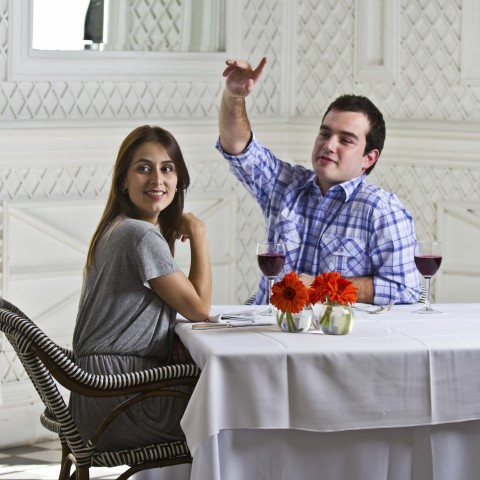
If the waiter asks you if you need anything else, you can also ask for the bill:
| De rekening alstublieft. (“The bill, please.”) Kunnen wij de rekening krijgen? (“Can we get the bill?”) Ja, ik zal de rekening voor u halen. (“Yes, I’ll get the bill for you.”) U kunt direct aan de balie betalen. (“You can pay directly at the counter.”) |
Then, when it’s time to pay:
| Willen jullie apart of samen betalen? (“Do you want to pay separately or together?”) Ik zal voor iedereen betalen. (“I will pay for everyone.”) Apart, alstublieft. (“Separately, please.”) |
B- What About the Tip?
The tips in the Netherlands are very rarely included in the price, so it is polite to give tips in restaurants, pubs, and some cafés. About ten to twelve percent would be appropriate. Dutch waiters don’t survive on tips, but they’re rarely paid very well, so a tip is a welcome bonus to their wage.
Tips are usually left on the table in the form of coins, a bill, or in a dedicated tip box at the counter. But you could also ask to add a certain amount or 10% to the bill when paying by card: Voeg maar tien procent toe als fooi. (“Just add ten percent as a tip.”)
- ➜ Would you like to see more common restaurant vocabulary and phrases with recorded examples to work on your pronunciation? Why not stop by our vocabulary list on Key Phrases for Restaurants.
4. How DutchPod101 Can Help You Learn More Dutch

In this guide, you have learned everything you need to know when going to a Dutch restaurant. You now know how to make a reservation and how to order food in Dutch. For each step, you know the tips and tricks, as well as Dutch restaurant vocabulary and phrases. Did we forget some specific situations you’d like to learn more about?
You can start practicing speaking Dutch and rehearsing these common Dutch phrases for restaurants by checking out the free vocabulary lists on DutchPod101.com. Each list contains a recorded pronunciation of the words and phrases it covers, making them perfect for getting your pronunciation just right! In addition, we provide a variety of free resources and audio/video lessons for learners at every level.
Would you like some special attention to your Dutch language learning? Remember that we also offer a Premium PLUS service with personal 1-on-1 coaching: MyTeacher. Let your private teacher help you with Dutch vocabulary, pronunciation, grammar, and much more. You’ll receive personalized exercises, constructive feedback, and interactive assignments.

Dutch Animal Names: The Ultimate List for Language Learners

How many Dutch animal names do you know? Although it may not be the first thing you want to study when you start learning Dutch, knowing how to talk about animals is important in any language. After all, our furry friends play a central role in our lives!
There are many Dutch animal words for you to discover, ranging from the names of pets to the most common bugs and reptiles. Some of this new vocabulary may be difficult to memorize, but there are plenty of words that may be easier than you’re expecting. Take, for example:
- Rat (“Rat”)
- Kat (“Cat”)
- Schaap (“Sheep”)
- Beer (“Bear”)
- Vis (“Fish”)
Are you ready to discover the Dutch animal world with DutchPod101?
In this article, you’ll learn the must-know Dutch animal names, animal body parts, verbs related to animals, and even some funny animal sounds in Dutch.
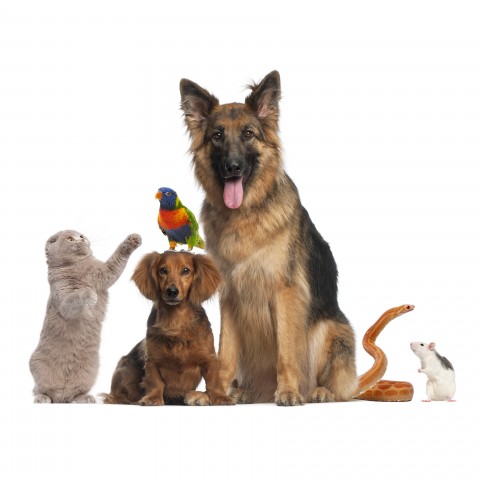
Learn some Dutch animal names with DutchPod101!
 Table of Contents
Table of Contents
- Pets
- Farm Animals
- Wild Animals
- Sea Animals
- Bugs and Insects
- Birds
- Reptiles & Amphibians
- Animal Body Parts
- Animal Verbs
- Animal Sounds in Dutch
- How DutchPod101 Can Help You Learn More Dutch
1. Pets
The Dutch are pet-loving people! A 2016 survey found that over half of Dutch households have at least one pet.
So, what are the most common Dutch pets? The most popular pet choices are dogs and cats; a 2019 survey showed that 18% of Dutch households owned a dog, while 23% owned a cat. Besides these more obvious furry friends, many Dutch households also have fish, a tame bird, or some small rodents (mice, rats, rabbits, or guinea pigs).
Check out this Dutch animals list to learn the names of common pets (and a few fun expressions that mention them):
| Kat | “Cat” |
| Dutch expression: Een kat in de zak kopen Literally: “To buy a cat in the bag” Meaning: To make a bad purchase | |
| Hond | “Dog” |
| Dutch expression: De hond in de pot vinden Literally: “To find the dog in the pot” Meaning: To arrive just too late for supper | |
| Konijn | “Rabbit” |
| Muis | “Mouse” |
| Dutch expression: Als de kat van huis is, dansen de muizen op tafel Literally: “When the cat’s away from home, the mice dance on the table.” Meaning: If there’s no supervision, people do what they want. | |
| Hamster | “Hamster” |
| Dutch expression: Hamsteren Literally: “To hamster” Meaning: To hoard | |
| Rat | “Rat” |
| Cavia | “Guinea pig” |
| Goudvis | “Goldfish” |
| Kanarie | “Canary” |

The Dutch word kat is very similar to the English “cat.”
- → Are you an animal lover? Then visit our World Animal Day vocabulary list and get ready to celebrate!
2. Farm Animals
Dutch farm animals are quite similar to those in many other countries: the same-old cows, pigs, sheep, chickens, and goats. The most typical Dutch farm animal is probably the black-and-white Dutch cow, as they’re so representative of scenic landscapes in the Netherlands.
Here are the names of common farm animals in Dutch:
| Koe | “Cow” |
| Dutch expression: Dat is een waarheid als een koe. Literally: “That’s as true as a cow.” Meaning: Sometimes, the truth is so obvious you can’t miss it. | |
| Varken | “Pig” |
| Dutch expression: Dat slaat als een tang op een varken. Literally: “That hits like pliers on a pig.” Meaning: That makes absolutely no sense. | |
| Schaap | “Sheep” |
| Dutch expression: Als één schaap over de dam is, volgen er meer. Literally: “When one sheep crosses the dam, more will follow.” Meaning: If one person starts, more will follow. | |
| Geit | “Goat” |
| Paard | “Horse” |
| Ezel | “Donkey” |
| Dutch expression: Zo koppig als een ezel Literally: “As stubborn as a donkey” Meaning: Being very stubborn | |
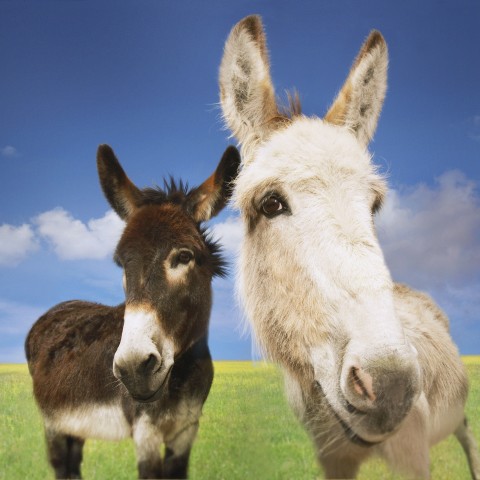
Are you as stubborn as a donkey?
| Kip | “Chicken” |
| Haan | “Rooster” |
3. Wild Animals
The Netherlands is a small country with relatively little nature, but don’t let that fool you into thinking there are no wild animals here. The Dutch forests, plains, and bodies of water host a variety of wild animals, such as foxes, wolves, deer, and badgers.
In this section, we’ll teach you the Dutch animal names for some of the most common wild animals you’ll find in the Netherlands. We’ll also provide the names of other wild animals, so you can talk about them when you visit the zoo!
| Beer | “Bear” |
| Wolf | “Wolf” |
| Hert | “Deer” |
| Vos | “Fox” |
| Dutch expression: Een vos verliest wel zijn haren maar niet zijn streken. Literally: A fox loses its hair but not its tricks. Meaning: People rarely really change. | |
| Das | “Badger” |
| Leeuw | “Lion” |
| Tijger | “Tiger” |
| Panter | “Panther” |
| Olifant | “Elephant” |
| Dutch expression: Als een olifant in de porseleinkast Literally: “Like an elephant in the china shop” Meaning: Being extremely careless or tactless | |
| Giraf | “Giraffe” |
| Aap | “Monkey” |
| Dutch expression: Nu komt de aap uit de mouw. Literally: “Now comes the monkey out of the sleeve.” Meaning: Now the truth (or someone’s real character) is being revealed. | |
| Nijlpaard | “Hippopotamus” |
| Pinguïn | “Penguin” |
| IJsbeer | “Polar bear” |
| Dutch expression: IJsberen Literally: “To polar bear” Meaning: To pace | |

When you’re pacing, the Dutch say that you’re walking around like a polar bear.
4. Sea Animals
The Dutch are surrounded by water: 17% of the total surface of the country consists of water, and the Netherlands has a coastline of 230 kilometers. This is quite long, if you take the size of the country into account.
So what kind of sea animals might you find here? There are several types of Dutch sea animals dwelling in the waters: fish, lobsters, mussels, and—the favorite Dutch sea animal—seals.
Here’s a brief list of sea animals in Dutch:
| Vis | “Fish” |
| Dutch expression: Als een vis op het droge Literally: “Like a fish out of water” Meaning: Refers to someone who cannot find his or her place, or who does not belong | |
| Haai | “Shark” |
| Dutch expression: Naar de haaien gaan Literally: “Going to the sharks” Meaning: “To go down” or “to encounter very big problems that threaten someone’s or something’s existence” | |
| Dolfijn | “Dolphin” |
| Zeehond | “Seal” |
| Walvis | “Whale” |
| Zeeleeuw | “Sealion” |
| Kwal | “Jellyfish” |
| Octopus | “Octopus” |
| Kreeft | “Lobster” |
| Zeester | “Starfish” |
| Mossel | “Mussel” |
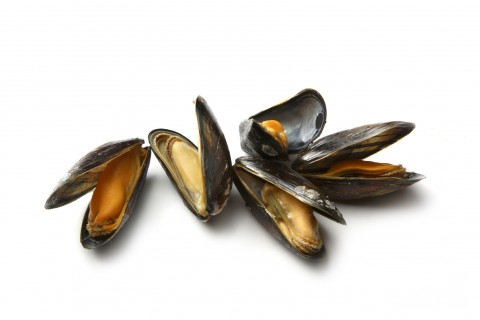
Mussels are a popular seafood in the Netherlands; have you ever tried them?
- → Do you want to dive deeper? Take a bite out of these Shark Week words with recorded examples.
5. Bugs and Insects
Fortunately, the Netherlands is not home to a lot of scary or dangerous insects. While there are many bugs and insects present in the Netherlands, most are not very big and you’ll probably have seen them before.
Here’s a Dutch animal list of the most common insects and bugs:
| Bij | “Bee” |
| Wesp | “Wasp” |
| Mug | “Mosquito” |
| Dutch expression: Van een mug een olifant maken Literally: “To make an elephant out of a mosquito” Meaning: To make something big out of a small problem, or to blow something out of proportion | |
| Vlieg | “Fly” |
| Spin | “Spider” |
| Sprinkhaan | “Grasshopper” |
| Vlinder | “Butterfly” |
| Dutch expression: Vlinders in je buik hebben Literally: “To have butterflies in your stomach” Meaning: To be in love | |
| Mier | “Ant” |
| Mot | “Moth” |
| Slak | “Snail” |
| Worm | “Worm” |
| Kever | “Beetle” |
| Lieveheersbeestje | “Ladybird” / “Ladybug” |

As is the case in many other countries, we refer to butterflies in the stomach when someone is in love.
6. Birds
The Netherlands has quite a lot to offer bird lovers, as the country has around 300 regular migrant and resident birds and a total of 534 bird species. The most common Dutch birds are seagulls, pigeons, crows, and sparrows. But the Netherlands also has a number of waterbirds, such as swans, ducks, and geese.
Did you know that in a city like Amsterdam, you can watch a lot of birds? And not only city birds like pigeons! Because of the canals and the bodies of water that surround Amsterdam, there are many waterbirds to watch as well.
Learn the Dutch names for these birds so that you can point them out every time you spot one!
| Duif | “Pigeon” |
| Zeemeeuw | “Seagull” |
| Kraai | “Crow” |
| Adelaar | “Eagle” |
| Uil | “Owl” |
| Ekster | “Magpie” |
| Mus | “Sparrow” |
| Zwaluw | “Swallow” |
| Dutch expression: Een zwaluw maakt de lente niet. Literally: “A swallow does not make spring.” Meaning: A circumstance does not lead to a final conclusion. | |
| Pauw | “Peacock” |
| Dutch expression: Trots als een pauw Literally: “To be proud as a peacock” Meaning: To be very proud | |
| Gans | “Goose” |
| Zwaan | “Swan” |
| Eend | “Duck” |
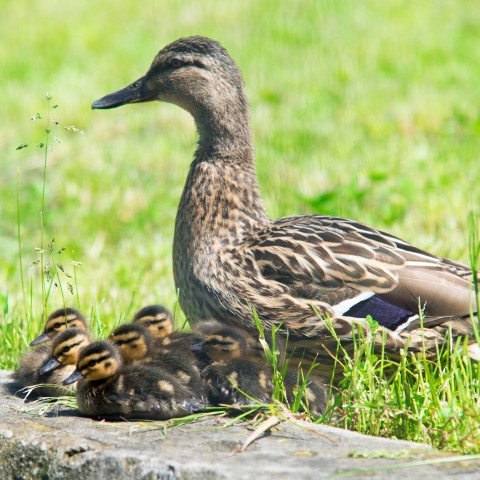
You’ll be able to see a lot of ducks in Dutch ponds.
7. Reptiles & Amphibians
The Netherlands is not home to many scary reptiles or amphibians, though you may be able to see several frogs and toads in nearby ponds. You may even be able to find a snake in the Netherlands, as the country has three snake species (only one of which is venomous). But don’t worry! It’s not that common to encounter a snake when exploring the natural surroundings here.
| Kikker | “Frog” |
| Pad | “Toad” |
| Slang | “Snake” |
| Krokodil | “Crocodile” |
| Dutch expression: Krokodillentranen huilen Literally: “To cry crocodile tears” Meaning: To feign your grief | |

Have you ever seen a crocodile tear?
| Hagedis | “Lizard” |
| Kameleon | “Chameleon” |
| Schildpad | “Turtle” |
| Zeeschildpad | “Sea turtle” |
- → Would you like to learn more Dutch animal names and listen to their pronunciation? Then have a look at this Animal Names vocabulary list.
8. Animal Body Parts
Now that you know several Dutch animal names, it’s time to learn some words that will help you describe them! Memorizing the animal body parts in Dutch will allow you to tell your new friends about the time you saved a bird with a broken wing, or the time your dog got its fur all dirty. Take a look:
| Staart | “Tail” |
| Vleugel | “Wing” |
| Haar | “Hair” |
| Vacht | “Fur” |
| Veer | “Feather” |
| Tand | “Tooth” |
| Hoektand | “Fang” |
| Klauw | “Claw” |
| Hoorn | “Horn” |
| Hoef | “Hoof” |
| Bek | “Mouth” |
| Snavel | “Beak” |
| Vin | “Fin” |
| Tentakel | “Tentacle” |
| Maan | “Mane” |
| Slurf | “Trunk” |
| Antenne | “Antenna” |
| Poot | “Leg” |
| Schub | “Scale” |
9. Animal Verbs
You can now name a variety of animals in Dutch and list their unique body parts…just one more thing is missing. Below, you’ll find several verbs related to animals that you can use in your next conversation!
| Miauwen | “To meow” |
| Blaffen | “To bark” |
| Brullen | “To roar” |
| Zoemen | “To buzz” |
| Grommen | “To growl” |
| Spinnen | “To purr” |
| Galoperen | “To gallop” |
| Bijten | “To bite” |
| Steken | “To sting” |
| Krabben | “To scratch” |
| Likken | “To lick” |
| Aaien | “To pet” |
| Temmen | “To tame” / “To train” |
| Voeden | “To feed” |
| Vaccineren | “To vaccinate” |
- → Would you like to learn more Dutch verbs? Have a look at our vocabulary lists 50 Most Common Verbs and 25 Most Commonly Used Verbs of Any Language.
10. Animal Sounds in Dutch
The onomatopoeia used for animal sounds varies greatly from one country to another, often resulting in hilarious situations when comparing animal sounds. Let’s take the rooster, for example:
- English: cock-a-doodle-doo
- Swedish: kuckeliku
- Spanish: qui-qui-ri-qui
For your entertainment, here are the most popular animal sounds in Dutch.

How does barking sound in Dutch? Woef!
| Miauw | (Cat) |
| Woef | (Dog) |
| Boe | (Cow) |
| Bêêê | (Sheep) |
| Roekoe | (Pigeon) |
| Kukeleku | (Rooster) |
| Kwak | (Duck) |
| Grrr | (Growling sound) |
| Oe oe | (Owl) |
| Kwaak | (Frog) |
| Knor knor | (Pig) |
- → Would you like to learn more animal sounds in Dutch? Then have a look at our Sounds That Animals Make vocabulary list, and don’t forget to listen to the recorded examples of these Dutch animal sounds.
11. How DutchPod101 Can Help You Learn More Dutch
In this guide, you’ve learned many Dutch animal names for pets, farm animals, insects, and much more. Now you’ll be able to talk with your Dutch friends about their pets or ask them about their favorite animals.
Did we forget any other important animals? Or would you like to know other animal sounds in Dutch? Please share with us in the comments below!
Make sure to explore DutchPod101.com, as we have plenty of free resources to help you practice your grammar and many useful vocabulary lists with audio recordings to help you learn new words.
Remember that Premium PLUS members can also take advantage of our MyTeacher service for 1-on-1 coaching. This way, you can practice your Dutch speaking skills with your own private teacher through interactive exercises and personalized feedback.
Happy learning!

Dutch Love Phrases: How to Say “I Love You,” in Dutch

Do you have a Dutch girlfriend or boyfriend, or has an attractive Dutchie caught your eye? Then learning how to express your feelings in the Dutch language is the first step you should take toward creating a new relationship or strengthening the bond between you and your lover.
Of course, there are the basics. For example…
How do you say “I love you,” in Dutch? That’s Ik hou van jou. And how about “my love”? That could be mijn lieverd or mijn liefje.
The Dutch may not be the most expressive people when it comes to love, but they do have their own ways of confessing their feelings and revealing their love to someone. With the right words, you’ll come a long way in your relationship—but try not to be too dramatic or clingy. The Dutch are very down-to-earth, and they view excessive romanticism as a mark of desperation.
Learn to talk about love in Dutch with this useful guide from DutchPod101.com. We’ve provided a variety of Dutch love phrases for every phase of your romantic relationship, from confessing your affection and falling in love all the way to getting married and starting a family. And if that’s still not enough, we’ll even introduce you to some Dutch endearment terms and must-know Dutch love quotes.
Let’s get to it!

Impress your Dutch love with these Dutch romantic phrases.
 Table of Contents
Table of Contents
- First Contact: Dutch Pick-up Lines and More
- Take it to the Next Level: How Do You Say “I Love You,” in Dutch?
- Take it One Step Further: “Will You Marry Me?” and More
- Dutch Endearment Terms: “My Love” in Dutch and More
- Must-know Dutch Love Quotes
- How DutchPod101 Can Help You Learn More Dutch
1. First Contact: Dutch Pick-up Lines and More
You’re in a bar and you spot some nice Dutchie you’d like to get to know…but how do you make first contact? While the Dutch value a direct approach in all things, it’s still important to know how to start the conversation. Have a look at these Dutch pick-up lines and other useful Dutch love phrases for when you’ve just met someone.
| Kom je hier vaker? Ik ken je ergens van. | “Do you come here often?” “I think I’ve seen you before.” |
| Hoe heet je? | “What’s your name?” |
- → What more can you say? Have a look at these 10 Lines You Need for Introducing Yourself.
| Wil je dansen? Wil je met me dansen? | “Do you want to dance?” “Do you want to dance with me?” |
| Wil je wat drinken? Ik betaal dit rondje. | “Can I buy you a drink?” “Let me get this round.” |
| In the Netherlands, it’s not customary that the man pays for everything. Rather, it’s quite common for couples to “go Dutch” and split the bill. However, when you meet someone new, offering a drink can be a good way to show your interest. While it’s less common for a girl to buy a guy a drink, this is definitely an option as well. | |
| Heb je een vriend? Heb je een vriendin? | “Do you have a boyfriend?” “Do you have a girlfriend?” |
| The Dutch are direct, so they’re used to non-subtle ways of asking if someone is single. You could also ask: Ben je single? (“Are you single?”) | |
| Het was leuk met jou.I k zou het leuk vinden om je nog een keer te zien. | “I had a great time with you.” “I’d like to see you again.” |
| Zullen we nog eens afspreken? Zullen we binnenkort wat drinken? | “Shall we meet another time?” “Shall we have a drink soon?” |
| In the Netherlands, a common first date is to have drinks together at a bar at night. Going for dinner is far less common, as it can be viewed as awkward if you don’t know the other person very well. | |

Are you ready to invite someone on a date in Dutch?
| Mag ik je telefoonnummer? Mag ik je mijn telefoonnummer geven? | “Can I get your phone number?” “Can I give you my number?” |
| It’s more common to ask for someone’s phone number than to ask if you may give your number to someone, and both men and women can do so. That said, giving your phone number to someone might be seen as more courteous. If your potential date is interested, they will either return the favor right away or call you later. | |
- → Now that you’ve made your move, you’ll want to know the Most Common Phrases You’ll Need for a Date.
→ Did someone ask you out on a date, but you’re not interested? Find out how to politely decline with these Ways to Reject an Invitation.
2. Take it to the Next Level: How Do You Say “I Love You,” in Dutch?
You went on that first date and many more. You’re in love and ready to take it to the next level. So, what’s “I love you,” in Dutch? And what else can you say to really win their affections? Here are several romantic Dutch phrases you can use to express your feelings.
| Ik vind je leuk. | “I like you.” |
| As mentioned before, the Dutch are not very expressive about their love. Saying this phrase to someone you’ve only just met may be seen as too fast or forward. It’s more common to express this after you’ve seen the other person several times. | |
| Ik mis je. | “I miss you.” |
| Ik heb zin om je weer te zien. | “I look forward to seeing you again.” |
| Ik denk aan jou. | “I’m thinking about you.” |
| Ik ben gek op jou. | “I’m crazy about you.” |
| Je bent zo mooi. | “You’re so beautiful.” |
| Ik ben verliefd op jou. | “I am in love with you.” |
| Wil je verkering met mij? Wil je een relatie met mij? Zullen we het officieel maken? | “Do you want to be in a relationship with me?” “Do you want to be in a relationship with me?” “Shall we make it official?” |
| Verkering is another word used to refer to a romantic relationship. Although it’s a common word, it might be perceived as a bit childish. If you’d prefer to stay on the safe side, use the word relatie (“relationship”). It has the same meaning, but it’s a more neutral word. If you’ve been dating your Dutchie for a while but the relationship has not become “official” yet, then you might want to use the last option. | |
| Ik houd van jou. Ik houd zielsveel van jou. | “I love you.” “I love you with heart and soul.” |
| Fun fact: Dutch people often use the phrase Ik hou van jou, with the d dropped from houd. Although the spelling is officially wrong, it’s a very common way to write the phrase. Where does this habit come from? The d might have been dropped simply because it’s not pronounced when the word is spoken. | |

Ready to write some love letters in Dutch?
- → Are you looking for some other romantic Dutch phrases to declare your undying love? Our list of Love Phrases for Valentine’s Day might be just what you need.
3. Take it One Step Further: “Will You Marry Me?” and More
You’ve expressed your feelings successfully, it’s been reciprocated, and you’re officially in a happy relationship. Are you ready to take it one step further? Here are all the Dutch love phrases you need to steer your relationship toward the future you want. We’ve gathered key phrases for expressing true love in Dutch, meeting the parents, moving in together, getting married, and even having a baby.
| Wij zijn voor elkaar bestemd. Jij bent de liefde van mijn leven. Ik kan niet zonder jou. | “We are made for each other.” “You are the love of my life.” “I can’t live without you.” |
| These romantic Dutch phrases are not used very often, so make sure you only say them in the right setting and that they come from the heart. The Dutch don’t take words like these lightly. | |
| Ik wil graag dat je mijn ouders ontmoet. | “I would like for you to meet my parents.” |
| As the Dutch move out of their parents’ place at a relatively young age and often move to another city when going to study, meeting the parents is a big deal in Dutch culture. | |
| Wil je met mij samenwonen? | “Would you like to move in together?” |
| Wil je met me trouwen? | “Do you want to marry me?” |

Pop the question in Dutch.
| Ik wil graag een kindje met jou. | “I would like to have a baby with you.” |
4. Dutch Endearment Terms: “My Love” in Dutch and More
What’s next, then? You’ll need some Dutch endearment terms to express your love each and every day. In the Netherlands, it’s very common to use endearment terms when talking to the people you love, whether it be your partner or your friends and family.
| Lieverd Schatje Liefje Dropje Lekker ding Knapperd | “Dear” “Cutie” “Little dear” “Sweetie” “Delicious thing” “Beautiful” |
| These are just some popular options, but there are many more! The same endearment terms also come in a lot of different forms and shapes, such as: lieffie, droppie, schatteke, knappie. It’s all a matter of preference, and many Dutch couples also use personal pet names. | |

What Dutch endearment term would you use?
5. Must-know Dutch Love Quotes
As you might have expected from the not-so-romantic Dutch, there is no overload of romantic love quotes in the Dutch language. And the quotes that do exist tend to have a down-to-earth undertone. That said, here are the most popular quotes about love in Dutch:
| Dutch | De liefde kan niet van één kant komen. |
| Literally | “Love cannot come from one side.” |
| Equivalent | It takes two to tango. |
| This is one of the down-to-earth Dutch love quotes that’s quite popular in the Netherlands. It shows the Dutch attitude about love, which is that love should come from both sides: If you want to make it work, both parties will have to contribute. | |
| Dutch | De liefde van een man gaat door de maag. |
| Literally | “A man’s love goes through the stomach.” |
| This humorous Dutch love quote may also say something about their not-so-romantic nature. This is a very popular Dutch quote, and it even has its own song. It can also be used for women, children, or even for animals. People may even say it about their own cat: De liefde van een kat gaat door de maag. (“The love of a cat goes through the stomach.”) | |
| Dutch | Ongelukkig in het spel, gelukkig in de liefde. |
| Literally | “Unlucky in the game, happy in love.” |
| Equivalent | Lucky at cards, unlucky in love. |
| This love quote in Dutch is nearly identical to its English counterpart. Those who always lose in gambling often have a happy love life, and vice-versa. What do you think about that? Is it true for you? | |
| Dutch | Oude liefde roest niet. |
| Literally | “Old love does not rust.” |
| This beautiful Dutch quote, with an identical English counterpart, also has its own song from the famous Dutch 80s band VOF De Kunst. They sing: Oude liefde roest niet, maar verdwijnt net zoals jij. (“Old love does not rust, but disappears just like you.”) | |
- → Find more love inspiration in our free vocabulary list of quotes on Love. Or go for those bittersweet Break-Up quotes.
6. How DutchPod101 Can Help You Learn More Dutch

You’re ready to find some Dutch love!
In this article, you learned how to say “I love you,” in Dutch and many more useful Dutch love phrases. You’re now prepared to get your flirt on, express your love, and even take it a step further with a solid marriage proposal. You also know what endearment terms to use for your Dutch lieverd (“dear”) and have some old Dutch love quotes to fall back on when you want to spice things up.
Did we forget any important Dutch love phrases you know? What’s your favorite romantic Dutch phrase or endearment term?
There’s still a lot more to learn, and nothing will make your Dutch lover swoon more than mastering their native tongue. Make sure to explore DutchPod101.com and take advantage of our numerous vocabulary lists with audio recordings and other useful free resources to boost your Dutch studies.
Would you like some 1-on-1 coaching? Then consider upgrading to a Premium PLUS subscription, which will give you access to our MyTeacher service. Here, you can learn more about Dutch love and life with your own private teacher and really master the Dutch language. Through personalized feedback and pronunciation advice, you’ll catch on in no time.

Why You Should Learn – Dutch

Learning a foreign language comes with several added benefits, from new business opportunities to a healthier mind.
But why learn Dutch, specifically? After all, there are plenty of other languages to choose from—some of which are in higher demand and more widely spoken.
There are many reasons why you should learn Dutch, and DutchPod101 is here to break it all down for you and show you that Dutch isn’t such a hard language to learn. With a little help and guidance, you’ll be able to tackle this fun challenge and advance toward your goals!
In this article, we’ll go over the 10 main reasons why you should start learning Dutch. We’ve included reasons related to: leisure (travel, friendship, love, culture); business (quality studies, work opportunities); and personal development (benefits of learning another language).
Let’s dive in.

So why should you learn Dutch?
 Table of Contents
Table of Contents
- Reasons Related to the Country and the Language
- Reasons Related to the Benefits of Learning a Language
- Reasons Related to Personal and Professional Aspects
- How DutchPod101 Can Help You Learn Dutch
1. Reasons Related to the Country and the Language
Some of the best reasons to learn Dutch have to do with the properties of the language itself, as well as the countries in which it’s spoken. Let’s take a closer look.
Reason 1: Learning Dutch is relatively easy.
So, why study Dutch? Because it’s quite easy, especially for English speakers. Here’s what we mean:
- Dutch is very similar to English and German.
If you speak English or German, mastering Dutch will not be too difficult for you. Dutch is very similar to these languages, making it one of the easiest languages for native English or German speakers to learn. Speaking one of these languages—even if not natively—will give you a headstart in your Dutch learning!
- You already know some Dutch words.
Nearly one-third of the Dutch language is borrowed, namely from English, French, German, and Hebrew. As such, knowing one or more of these languages will make it easier for you to pick up Dutch.
- Dutch people will appreciate your efforts.
The Dutch are used to foreigners speaking in English with them. So when foreigners (try to) speak Dutch, native speakers are pleasantly surprised and are happy to help. They’ll appreciate your effort, try to speak extra-slow, and help you whenever you get stuck.
You might need to make it clear first that you really prefer to speak Dutch, as they’ll switch to English out of habit if you don’t. But once that’s cleared up, their willingness to help will turn out to be one of the best things about learning the language.
- Your pronunciation and grammar don’t have to be perfect.
The Dutch aren’t too snobby or arrogant regarding their language. Mistakes are okay, and even Dutch natives can be quite sloppy with their own language. Grammar rules aren’t always taken into account, and even the pronunciation isn’t always perfect.
The Netherlands may be a small country, but it has a lot of dialects and accents from region to region. That’s why there’s no such thing as perfect Dutch pronunciation. Take, for example, the hard g sound in the north and the soft g sound in the south. Of course, you should try to learn Dutch the best you can, but it’s simply okay to make mistakes.
If you’d like to learn more about why learning Dutch is easier than you might think, make sure to visit our full article Is Dutch Hard to Learn?
Reason 2: Dutch is spoken in more places than you might think.
Dutch is the official language of the Netherlands and Suriname, and it’s one of the official languages in Belgium, Aruba, Bonaire, and Curaçao. It’s spoken in most of the former Dutch colonies and in small emigrant communities all over the world. Dutch is also the parent language of Afrikaans, one of the 150 official languages of South Africa. (Before Afrikaans was officially recognized by linguists, Dutch itself was one of the official languages here.)
So, why learn Dutch? Because there are about 23 million people registered as native Dutch speakers all over the world and another 5 million speak Dutch as a secondary language.
Reason 3: You’ll get to know the rich Dutch culture and history.
When you learn a language, even if you’re just focusing on practical topics such as grammar and vocabulary, you’ll get to know more about the culture and the history of its native speakers.
As your thoughts are shaped by the language you speak, learning the Dutch language will give you some insight regarding how the Dutch think. Learning a language is like opening a window into the Dutch culture, history, and way of life. And if this is too philosophical for you, there’s also a more practical reason why learning Dutch will help you learn the country’s culture and history: It’s the perfect way to be able to connect with the locals. If you can’t have a conversation with the Dutch, how can you get to know their country?
Yes, of course, many Dutchies speak English, but the culture and history of a country includes its language, sayings, humor, and even songs. So, while learning Dutch, you’ll be able to get to know all these different aspects of the Dutch culture.
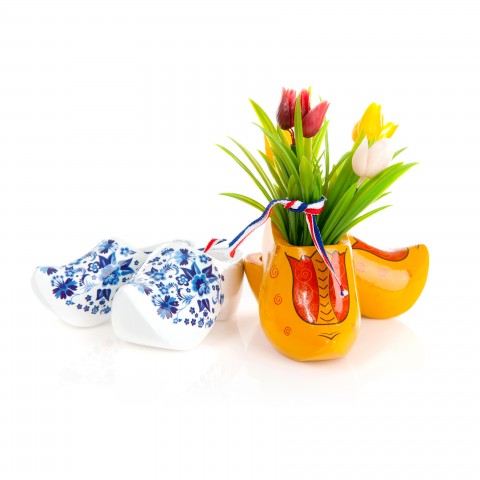
How well do you know the Dutch history and culture?
- → Going to the Netherlands? Don’t leave without these Top 30 Travel Phrases You Should Know.
Reason 4: Dutch is a funny language.
The Dutch language has a very funny pronunciation with a lot of tricky sounds. It may not be the smoothest or sexiest language in the world, but it has some funny sounds no other languages seem to have.
Dutch has a lot of vowels, as it uses single vowels, double vowels, and diphthongs. A diphthong is a pair of vowels that, together, make a particular sound that no vowel on its own has. The Dutch alphabet has six vowels (a, e, i o, u, y) and nine diphthongs:
| Letter | (English) Pronunciation | Example |
| ai | Pronounced as [I] in “I am” in English | mais (“corn”) |
| au | Pronounced like [ow] in the English word “now” | auto (“car”) |
| ei | Pronounced as the [i] in the English word “find” | ei (“egg”) |
| eu | This sound doesn’t exist in English, but you may know it from the French word “beurre.” | leuk (“fun”) |
| ie | Pronounced like [ee] in the English word “bee” | mier (“ant”) |
| ij | Pronounced exactly the same as the Dutch ei diphthong | wijn (“wine”) |
| oe | Pronounced like [oo] in the English word “pool” | moe (“tired”) |
| ou | This diphthong has exactly the same sound as the Dutch au diphthong. | koud (“cold”) |
| ui | This sound doesn’t exist in English, but it’s a combination of the [a] sound in “man” followed by a long Dutch u. | muis (“mouse”) |
But that’s not all. The Dutch language even has triple vowels:
| Letter | (English) Pronunciation | Example |







